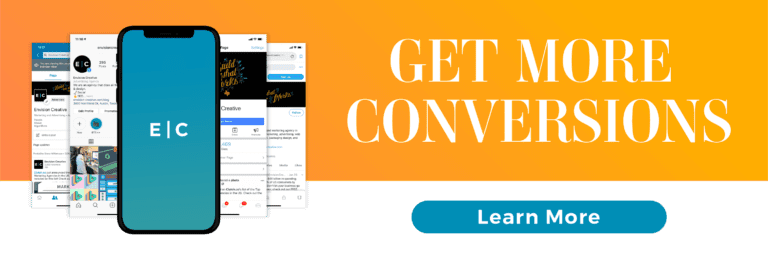Let’s start here: CRO (conversion rate optimization) tools have an average ROI of 223%!*
Yeah, that’s nothing to sneeze at but, for a lot of businesses, CRO isn’t a familiar part of their business-y vocabulary wordbank. Today’s post aims to change that! Let’s talk about Conversion Rate Optimization and why it should be part of all of your strategies.
What is Conversion Rate Optimization?
You know I love two things in a blog: stats and definitions. I started out with a stat (there are more to come, obviously) so let’s define CRO:
CRO, or conversion rate optimization, is the practice of increasing the number of visitors that complete a predetermined conversion activity.
CRO isn’t just ONE thing, it’s many things strung together to make a strategy. Just like SEO isn’t just link building, CRO operates on many levels at once from UX to content marketing to pay per click to automation tools. It’s a mood, it’s a look.
The easy bake oven version of it is that it’s the strategy you implement to help increase the number of conversions you’re getting on your website, landing page, social ads, email, app download, etc.
Why is it a thing? Because, at the end of the day, while there are many metrics and KPAs you can measure to chart the efficacy of your marketing efforts, conversions are sometimes the only thing that really matters. CEOs don’t necessarily care about engagement rates, but they do care about how many conversions you’re getting!
We’ll be covering best practices and examples in a section further down the page.
The Benefits of CRO
There are many reasons why you should implement a CRO strategy and while I can (and will) list several reasons to do it, there is one big reason that matters above all else:
Your competitors are doing it.
That’s right. Over 44% of companies use split (or A/B) testing tools (source) and that number is growing as more and more businesses (both B2B and B2C) invest more in digital and marketing automation tools. If you haven’t already formed your CRO strategy, you’re behind.
Still not convinced? That’s ok, it should take more than a stat or two to change your mind. Here are a few other benefits of CRO that can help make you a conversion hero:
CRO helps Increase our web traffic.
Not all visitors convert, sure, but when you have more visitors, you have more chances to convert! And once they do convert? They’re more likely to come back for more conversions and encourage their peers, friends, and family to do so by sharing content on social media which, in turn, helps generate even more traffic.
Visitors that convert and become customers will be more likely to leave positive reviews as well, which will also help provide a boost to your traffic. Last, but not least, high conversion rates mean higher engagement levels, which can help boost page rankings and bring in more organic traffic from search engines. These are all exciting things.
CRO helps you focus on customers.
While it’s nice to think that every moment of every day you’re living and breathing the needs of your customers, sometimes that’s just not possible. Optimizing your conversion rate requires you to examine address the needs and challenges of your customers in a more straightforward way.
Improving user experience on your website to improve your conversion rates will keep your user’s best interest at the center of everything you do. It’s kind of like a very profitable altruism!
CRO helps increase your profits.
We all want to provide thoughtful, relevant services to our clients, whatever it is we provide. But, at the end of the day, whether you’re answering to your boss or your shareholders, what they want to see if profit.
The most obvious benefit of all is that the better your conversion rate is, the more your profits will increase. Through a good CRO strategy, you’ll be spending the same to attract customers, but you’ll be closing more of them, resulting in higher profits.
Implementing a CRO Strategy
As I mentioned in an earlier section, CRO is not just one thing, it’s many things put together to make a cohesive, holistic strategy.
Before you get too far into the weeds, you want to make sure you know what your current conversion rate is. One of the easiest ways to do this is through the power of simple math (simple, I promise!):
# of conversions / total interactions = conversion rate
Let’s say you had 80 conversions on a landing page. There were 2,240 users driven to that landing page through a display ad and you need to know what % converted.
80 conversion / 2,240 visitors = 3.57% conversion rate
First of all, congrats on that. The average landing page conversion rate is about 2.35%. But this is a fake example so you may find you have different numbers. If they’re higher, that’s ok! If they’re lower, that’s ok, too! A strategy has to start somewhere and when you’re marking where you’re starting, these benchmark metrics are the ultimate way to show how you’ve grown.
Once you have your average conversion rates, it’s time to think about how you’re going to put your CRO strategy together. Here are a few things to think about:
Make sure you have a unique value proposition
It doesn’t matter what industry your business is in or what niche you’re trying to corner, you’re going to have competition so knowing how you’re different is a key ingredient to letting customers know why they should choose you over anyone else.
Visitors are more likely to visit competing sites when doing their research instead of converting on your site if they don’t know what makes your company special. It’s why you need to emphasize your unique value proposition early and often! If visitors clearly understand how your business differs from similar businesses, they’ll be more likely to convert.
Provide incentives to convert
You can’t expect visitors to follow your CTAs without a good reason. Why should anyone sign up to your email list or fill out your form without a reason? Adding incentives to convert will boost your conversion rates. Offering free downloadable content, like white papers or eBooks, or free product trials are examples of how you can effectively incentivize visitors to convert.
Remember to ask yourself: What does the customer get out of this?
Eliminate conversion roadblocks
This is an important one and something we come across more often than not when creating foundational strategies for our new clients.
Also note: There are many things that can prevent conversions. Like…a lot of things. So.many.things.
But, per the usual, I have some examples for you to look at so you have a reasonable place to start:
- Slow load times
- Poor navigation
- A lack of product images
- Poor product descriptions
- Confusing checkout process
- A lack of CTAs
- Cluttered page layouts
- High prices
This is by no means a comprehensive list, but once you start down this rabbit hole you’ll begin to discover other ways you can improve user experience and eliminate roadblocks for your customers.
Ensure the security of your visitors
No one wants to be scammed and the average internet user has become very wary of handing over their information, especially if they’re not as familiar with the brand. Visitors who are unfamiliar with your brand are going to be uneasy about converting right away. This means that you have to prove to them that you are a legitimate business and that any information they provide, whether it’s their email address or their credit card information, will be safe.
Help increase your authority and legitimacy by adding social proof in the form of reviews, testimonials, certifications, and awards. You should also make sure that your site has SSL certification, which ensures that their personal information is encrypted.
But wait! There’s more!
Conversion Rate Optimization is a living, breathing animal and expecting to become an expert from one blog post (even one as well-written and entertaining as this one) is a big ask. If your CRO strategy is in its nascent stages, that’s ok! Just knowing that you have work to do means you’re ahead of some of your competitors (but not all of them!). If you have more questions about why CRO is important and how to get a CRO strategy integrated across channels for your business, just reach out! We have some good things to say on this subject.
-FINAL(01-00)-White&Blue-01.svg)





